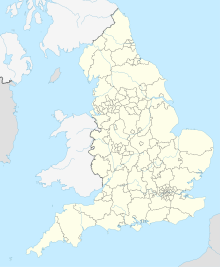Coverack to Porthoustock
| Site of Special Scientific Interest | |
 Trebarveth salt works along the shore of the SSSI | |
| Location | Cornwall |
|---|---|
| Grid reference | SW798195 |
| Coordinates | 50°02′05″N 5°04′37″W / 50.0347°N 5.0769°W |
| Interest | Biological/Geological |
| Area | 173.46 hectares (1.735 km2; 0.6697 sq mi) |
| Notification | 1951 |
| Natural England website | |
Coverack to Porthoustock is a coastal Site of Special Scientific Interest (SSSI) in Cornwall, England, UK, noted for both its biological and geological characteristics. The site contains four ICUN Red List plant species.
Geography
[edit]The 173.5-hectare (429-acre) site, notified in 1951, is situated on the south Cornish coast, within St Keverne civil parish on the Lizard Peninsula. It starts at the village of Coverack in the south, following the shores of the English Channel to the hamlet of Porthoustock in the north.[1][2]
The South West Coast Path runs through the SSSI, part of the coastline around Lowland Point is owned by the National Trust and contains two Geological Conservation Review sites.[2][3]
Wildlife and ecology
[edit]The coastline contains four Red Data Book plant species, Cornish heath (Erica vagans), dwarf rush (Juncus capitatus) and twin-headed clover (Trifolium bocconei) along with the nationally scarce autumn squill (Scilla autumnalis).[3]
History
[edit]On a raised beach between Pedn-myin (penn, head and meyn stone) and Lowland Point are the 2nd-century, Romano-British Trebarveth saltworks (grid reference SW79651933). Gabbro is the predominant rock here and weathers to a rough clay. Sea water was boiled in two rectangular, stone ovens within an oval building, The residue salt was packed into pots made from the gabbro clay, and course, red pottery sherds (briquetage) can be found in the nearby cliff. Some of the sherds still have potters' fingermarks on them. The ovens measure 150 cm by 40 cm and if packed with vessels 15 cm high, the oven would hold 50 lt of sea water. With the water containing 3% salt by weight, each operation would produce 1½ kg of salt. The saltworks are within a field system and some of the remaining walls stand up to 1 m high.[4][5][6]
References
[edit]- ^ "Coverack to Porthoustock map". Natural England. Archived from the original on 13 October 2012. Retrieved 28 November 2011.
- ^ a b Ordnance Survey: Landranger map sheet 204 Truro & Falmouth ISBN 978-0-319-23149-4
- ^ a b "Coverack to Porthoustock" (PDF). Natural England. 1993. Archived from the original (PDF) on 24 October 2012. Retrieved 28 November 2011.
- ^ Bates & Scolding 2000, pp. 24–28
- ^ Historic England & 1004319
- ^ Peacock, D P S (1969). "A Romano-British Salt-working Site at Trebarveth, St Keverne". Cornish Archaeology. 8: 47–65.
Sources
[edit]- Historic England, "Multi-period archaeological landscape of settlements, field systems, flint working, salt working and pottery production 450m SSE of Trevarbeth (1004319)", National Heritage List for England, retrieved 2 November 2018
- Bates, Robin; Scolding, Bill (2000). Beneath the Skin of The Lizard. Truro: Cornwall County Council. ISBN 1 8981 66 09 9.


